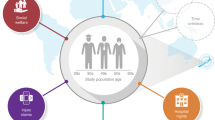Abstract
The Navajo are the largest Indian tribe in the continental U.S. with a population in 1986 estimated at 171,097. The Navajo Nation (Reservation) is located along the borders where Arizona, New Mexico, Colorado and Utah meet. Social and economic changes have accrued among the Navajo at a rapid rate during this century. At present, revenues are derived from oil, coal and uranium and from federal grants and contracts. High unemployment rates have been a major problem among the Navajo.
This article reviews health, disease and health care among the present day Navajo. Mortality rates from accidents and suicide are disproportionately high and have as their causes longstanding social and behavioral problems. Although there has been a sharp decline in morbidity and mortality from infectious diseases, there are still major environmental health problems.
Similar content being viewed by others
References
Haraldson, SSR:Health planning in sparsely populated areas. Dissertation. University of Gothenburg, Sweden, 1975
Haraldson, SSR:Role of education in preserving of traditional cultures and as development factor. Amsterdam. Elsevier Science Publishers. Health Policy and Education, 3, 1983 (pp 289–305)
Haraldson SSR: What expectations do we have in respect of front-line health services for adversely situated populations.Circumpolar Health 84 Proceedings of the Sixth International Council on Circumpolar Health, edited by R. Fortuine, Seattle, University of Washington Press, 1985. (pp 17–21)
U.S. Department of Commerce, Bureau of Census:1980 Census of Population Ancestry of the Population by State; Pub #PC80-S1-10; U.S. Government Printing Office, Washington, D.C. 20402
U.S. Department of Health & Human Services, Public Health Service;HHS News, July 3, 1984, Rockville, Maryland
U.S. Department of Health & Human Services, Public Health Service, Program Statistics Branch,Indian Health Service Chart Series Book, April, 1986. Rockville, Maryland, 1986
Tribal Council Compromises,Gallup Independent Newspaper. Gallup, New Mexico, September 22, 1983, p.1
Apache County 2nd-poorest in U.S.,The Arizona Daily Star, Tucson, Arizona, March 26, 1986
Fischler, R. and Fleshman, C.: Comprehensive Health Services for Developmentally Disabled Navajo Children;Journal of Developmental and Behavioral Pediatrics, 1985, 6:1–14
Dutton, Bertha:Navajos and Apaches: The Athabascan Peoples, Englewood Cliffs, N.J. Prentice-Hall Publishers, 1975
Broudy, D. and May, P.: Demographic and Epidemiologic Transition Among the Navajo Indians.Social Biology: 1984; 30:1–15
Wegman, M.: Annual Summary of Vital Statistics—1981,Pediatrics, 1985; 76:861–871
Additional information
Sixten S.R. Haraldson, Dr. Med, M.P.H. is Professor of International Development, Clark University and a former Director of the Nordic School of Public Health, Sweden. Address request for reprints to: Dr. Sixten S.R. Haraldson P.O. Box 5, 432 03 Traslovslage, Sweden.
The author made study visits to Indian reservations in Arizona in the U.S. in 1974, 1984 and 1985, and had valuable discussions with Catherine Fleshman, M.P.H., B.A. and Kenneth Fleshman, M.D. Both have extensively dealt with health problems among the Navajos and other Native Americans. Dr. Fleshman has practiced clinical medicine and public health with the Indian Health Service for thirty years. Ms. Fleshman is presently conducting health care management implementation studies for a southern Arizona tribe. I am most grateful for their assistance with statistical information and with their unique personal experience.
Rights and permissions
About this article
Cite this article
Haraldson, S.S.R. Health and health services among the Navajo Indians. J Community Health 13, 129–142 (1988). https://doi.org/10.1007/BF01324239
Issue Date:
DOI: https://doi.org/10.1007/BF01324239




